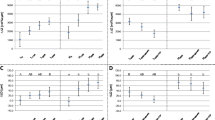Abstract
Objectives
To evaluate the remineralizing efficacy of fluoride in early carious lesions using a novel microbial pH-cycling model that combines the chemical pH-cycling model with dental microcosm biofilms.
Materials and methods
Artificial carious lesions were formed in 48 bovine incisors. The chemical and microbial pH-cycling models were applied to 24 specimens, respectively; the latter was applied after formation of dental microcosm biofilms for 6 days, based on the human saliva inoculation. The pH-cycling schedule was repeated for 12 days. All specimens were evaluated for fluorescence loss (ΔF) using quantitative light-induced fluorescence-digital before and after the pH-cycling. Specimen biofilms were further analyzed for red/green values (R/G ratios) and colony-forming units (CFUs). One-way analysis of variance and Tukey’s post hoc analysis were used to analyze change in fluorescence loss (ΔΔF) according to the pH-cycling model and treatment.
Results
When the chemical pH-cycling and microbial pH-cycling models were used, ΔΔF was 1.36 (p = 0.008) and 1.17 (p > 0.05) times higher, respectively, in the fluoride-treated group than that in the distilled water-treated group. In the microbial pH-cycling model, R/G ratios and CFU counts of biofilms were not significantly different between treatments (p > 0.05).
Conclusions
No significant difference was observed in the remineralizing efficacy of fluoride according to the presence of dental biofilms covering early carious lesions.
Clinical relevance
The remineralizing efficacy of fluoride could be overestimated in the absence of dental biofilms. Therefore, for accurate evaluation of the clinical value of remineralizing agents, dental biofilms should be included in in vitro tests.






Similar content being viewed by others
References
Featherstone J (2009) Remineralization, the natural caries repair process—the need for new approaches. Adv Dent Res 21:4–7
Bagramian RA, Garcia-Godoy F, Volpe AR (2009) The global increase in dental caries. A pending public health crisis. Am J Dent 22:3–8
Pitts N, Amaechi B, Niederman R, Acevedo A-M, Vianna R, Ganss C, Ismail A, Honkala E (2011) Global oral health inequalities dental caries task group—research agenda. Adv Dent Res 23:211–220
Kidd E, Fejerskov O (2004) What constitutes dental caries? Histopathology of carious enamel and dentin related to the action of cariogenic biofilms. J Dent Res 83:35–38
Takahashi N, Nyvad B (2011) The role of bacteria in the caries process: ecological perspectives. J Dent Res 90:294–303
Deng D, Ten Cate J (2004) Demineralization of dentin by Streptococcus mutans biofilms grown in the constant depth film fermentor. Caries Res 38:54–61
Vogel GL (2011) Oral fluoride reservoirs and the prevention of dental caries. In: Mar B (ed) Fluoride and the oral environment, vol 22. Karger Publishers, Basel, pp 146–157
Robinson C (2009) Fluoride and the caries lesion: interactions and mechanism of action. Eur Arch Paediatr Dent 10:136–140
Zhang M, He L, Exterkate R, Cheng L, Li J, Ten Cate J, Crielaard W, Deng D (2015) Biofilm layers affect the treatment outcomes of NaF and nano-hydroxyapatite. J Dent Res 94:602–607
Aas JA, Griffen AL, Dardis SR, Lee AM, Olsen I, Dewhirst FE, Leys EJ, Paster BJ (2008) Bacteria of dental caries in primary and permanent teeth in children and young adults. J Clin Microbiol 46:1407–1417
Bowden G (1997) Does assessment of microbial composition of plaque/saliva allow for diagnosis of disease activity of individuals? Community Dent Oral Epidemiol 25:76–81
Kim HE (2014) Change of paradigms in caries-associated bacteria in the caries process: ecological perspectives. J Dent Hyg Sci 14:87–93
Filoche S, Soma K, Sissons C (2007) Caries-related plaque microcosm biofilms developed in microplates. Oral Microbiol Immunol 22:73–79
Lee ES, Kang SM, Ko HY, Kwon HK, Kim BI (2013) Association between the cariogenicity of a dental microcosm biofilm and its red fluorescence detected by quantitative light-induced fluorescence-digital (QLF-D). J Dent 41:1264–1270
Lee ES, De Jong EDJ, Jung HI, Kim BI (2018) Red fluorescence of dental biofilm as an indicator for assessing the efficacy of antimicrobials. J Biomed Opt 23:015003
White D, Fuller R (1987) Fluoride uptake from anticalculus dentifrices in vitro. Caries Res 21:40–46
Ten Cate JM (1990) In vitro studies on the effects of fluoride on de-and remineralization. J Dent Res 69:614–619
Kim HE, Kim BI (2018) Prediction of early caries prognosis after fluoride application based on the severity of lesions: an in situ study. Photodiagn Photodyn Ther 23:45–49
Marsh PD (2004) Dental plaque as a microbial biofilm. Caries Res 38:204–211
Watson P, Pontefract H, Devine D, Shore R, Nattress B, Kirkham J, Robinson C (2005) Penetration of fluoride into natural plaque biofilms. J Dent Res 84:451–455
Robinson C, Kirkham J, Percival R, Shore R, Bonass W, Brookes S, Kusa L, Nakagaki H, Kato K, Nattress B (1997) A method for the quantitative site-specific study of the biochemistry within dental plaque biofilms formed in vivo. Caries Res 31:194–200
Funding
This work was supported by the National Research Foundation of Korea, funded by the Korean government (Ministry of Science and ICT) (grant number NRF-2019R1F1A1058152).
Author information
Authors and Affiliations
Corresponding author
Ethics declarations
Conflict of interest
The authors declare that they have no conflict of interest.
Ethical approval
This study was performed in line with the principles of the Declaration of Helsinki. Approval was obtained from the Institutional Review Board of Gachon University (1044396-201805-HR-118-01).
Informed consent
Not applicable.
Additional information
Publisher’s note
Springer Nature remains neutral with regard to jurisdictional claims in published maps and institutional affiliations.
Rights and permissions
About this article
Cite this article
Hwang, HY., Kim, HE. Influence of a novel pH-cycling model using dental microcosm biofilm on the remineralizing efficacy of fluoride in early carious lesions. Clin Oral Invest 25, 337–344 (2021). https://doi.org/10.1007/s00784-020-03463-6
Received:
Accepted:
Published:
Issue Date:
DOI: https://doi.org/10.1007/s00784-020-03463-6




